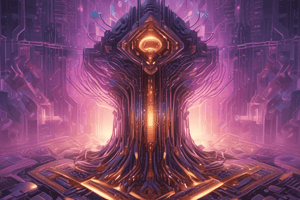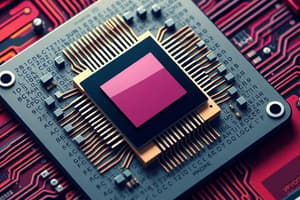Podcast
Questions and Answers
Which component of the CPU is responsible for performing arithmetic and logical operations?
Which component of the CPU is responsible for performing arithmetic and logical operations?
- Registers
- Control Unit
- Cache Memory
- Arithmetic Logic Unit (correct)
Read-Only Memory (ROM) is a type of memory that allows writing data frequently.
Read-Only Memory (ROM) is a type of memory that allows writing data frequently.
False (B)
What is the primary function of the Control Unit (CU) in the CPU?
What is the primary function of the Control Unit (CU) in the CPU?
To direct the operation of the processor and manage the execution of instructions.
The ______ stores data temporarily for active processes and is volatile memory.
The ______ stores data temporarily for active processes and is volatile memory.
Match the following terms with their definitions:
Match the following terms with their definitions:
What is the function of the Arithmetic Logic Unit (ALU)?
What is the function of the Arithmetic Logic Unit (ALU)?
The control bus carries data from the CPU to RAM.
The control bus carries data from the CPU to RAM.
What does the data bus link?
What does the data bus link?
MAR stands for __________.
MAR stands for __________.
Match the following registers with their functions:
Match the following registers with their functions:
Which component of the CPU is responsible for arithmetic and logical operations?
Which component of the CPU is responsible for arithmetic and logical operations?
The Control Unit (CU) is responsible for fetching new commands and executing them.
The Control Unit (CU) is responsible for fetching new commands and executing them.
What does the Program Counter (PC) store?
What does the Program Counter (PC) store?
The ________ holds the data that will be written to RAM or that was read from RAM.
The ________ holds the data that will be written to RAM or that was read from RAM.
Match the following CPU registers with their functions:
Match the following CPU registers with their functions:
What is the primary role of the Accumulator in the CPU?
What is the primary role of the Accumulator in the CPU?
Dual core technology indicates that a CPU has two Control Units.
Dual core technology indicates that a CPU has two Control Units.
What connects the Program Counter (PC) to the memory?
What connects the Program Counter (PC) to the memory?
What does CPU stand for?
What does CPU stand for?
The Control Unit is responsible for performing arithmetic and logic operations.
The Control Unit is responsible for performing arithmetic and logic operations.
What is the function of the Memory Address Register (MAR)?
What is the function of the Memory Address Register (MAR)?
The ________ is responsible for fetching data/instructions and executing program instructions.
The ________ is responsible for fetching data/instructions and executing program instructions.
Match the following components with their functions:
Match the following components with their functions:
Which register holds the data to be read from or written to memory?
Which register holds the data to be read from or written to memory?
A computer system has no storage components.
A computer system has no storage components.
What is included in a simplified model of CPU connections?
What is included in a simplified model of CPU connections?
Flashcards are hidden until you start studying
Study Notes
Computer Organization and Architecture
- Central Processing Unit (CPU): Core component responsible for fetching, decoding, and executing instructions from main memory (RAM).
- Arithmetic Logic Unit (ALU): Performs arithmetic (+, -) and logical (AND, OR) operations; essential for calculations and comparisons.
- Control Unit (CU): Directs CPU's operations by managing instruction sequencing, data flow, and coordinating the ALU's functions.
- Registers: Small, fast storage locations within the CPU that hold intermediate values; key registers include:
- Memory Address Register (MAR): Stores the address of the instruction/data to be fetched from RAM.
- Memory Data Register (MDR): Holds the data being written to or read from RAM.
- Accumulator: Temporarily stores results of arithmetic or logical operations performed by the ALU.
- Program Counter (PC): Tracks the address of the next instruction/data to be fetched.
Memory Types
- Primary Memory: Includes RAM (volatile storage) and ROM (non-volatile storage).
- Random Access Memory (RAM): Temporary storage for data and instructions while in use.
- Read-Only Memory (ROM): Permanent storage that holds essential system instructions.
- Cache Memory: Fast memory located close to the CPU to speed up data access by storing frequently used data.
System Architecture
- Computer System Components: Comprised of hardware and software that perform input, processing, output, and storage functions.
- Buses: Communication pathways that connect the CPU to other components:
- Data Bus: Transports actual data to/from RAM and CPU via MDR.
- Control Bus: Transmits control signals ensuring proper operation between the CPU and other devices.
- Address Bus: Carries addresses specifying memory locations for data transfer.
Functionality Overview
- Machine Instruction Cycle: The process where programs/data are sequentially loaded from storage into RAM and executed by the CPU one instruction at a time.
- Logic Gates: Basic building blocks in digital circuits that execute Boolean operations (AND, OR, NOT, NAND, NOR, XOR).
Key Concepts in Binary Representation
- Bit: A binary digit, the smallest unit of data in computing.
- Byte: Typically consists of 8 bits; fundamental unit of data storage.
- Number Systems:
- Binary: Base 2, used by computers.
- Denary/Decimal: Base 10, commonly used by humans.
- Hexadecimal: Base 16, often used in programming and memory addressing.
Recap of Functions
- ALU Functions: Executes arithmetic and logical operations; performs complex calculations and data handling.
- CU Functions: Manages instruction cycles and controls data flow among CPU components.
- Relationship between MAR and MDR: MAR fetches data from specific memory addresses, while MDR stores the data either fetched from or written to RAM.
Studying That Suits You
Use AI to generate personalized quizzes and flashcards to suit your learning preferences.




